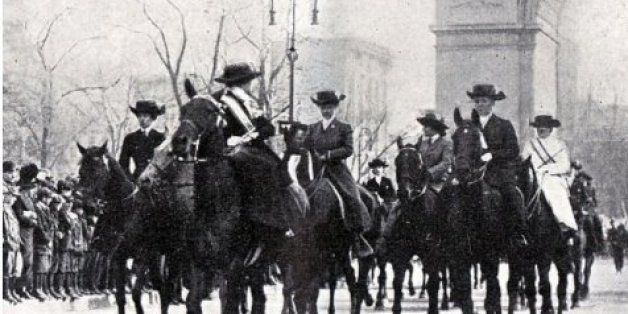
"The Streets Belong to the People," said New York Suffragists in 1912.
Their names are not engraved in the historical records, but Mrs. Lillian S. Griffin and Mrs. H.A. Saunders are worth remembering as protestors flood the streets of our cities right now.
It was 1912 and the Alderman of New York City were considering an ordinance to restrict parading on Fifth Avenue. Members of the Fifth Avenue Association, department store owners, preferred the smooth functioning of shopping on a Saturday to the proposed tramping of marching feet, which would hamper the flow of commerce. But the Woman Suffrage Party of New York, to which those women belonged, was planning a great event on that Avenue for the spring of 1912.
Their argument was simple.
"We feel that this city is for the people -- that its streets are for the people," Mrs. Griffin said.
"I wish to emphatically endorse the words of my sister here," added Mrs. Saunders.
The merchants caved, some even agreeing to drape their storefronts in yellow bunting or green, white and purple ribbons in support of the "Votes for Women" parade.
Late in the afternoon of May 6, 1912, at least one major street did belong to 20,000 of "the people" who came out to march and to the many thousands more who came to cheer or jeer on the sidewalks.
It began in Washington Square with a phalanx of women riding astride on horseback. Bands played, automobiles carried pioneers too frail to walk, and brilliant hand-sewn banners identified dozens of organizations from all corners and all classes of the city. Disruption came only when the Men's League entered the ranks, eliciting cat calls of "Who's minding the children?" from spectators and taunting renditions of "Ring Around A Rosy" as they moved up Fifth Avenue.
The Wage Earners League, with its seamstresses, laundresses and other sweatshop workers, was there in force, along with the College Equal Suffrage League, and contingents of teachers, actresses, doctors. A "colored women's division" marched with the New York Suffrage Party, though they did not show up in the picture spreads of the next day's mainstream newspapers. Victims of the horrendous Triangle Shirtwaist factory fire the previous year were remembered by friends carrying a black banner lettered with the words: "We Want The Vote for Protection."
For perhaps the last time in suffrage history, the Socialist party was present in large numbers, a scarlet-sashed contingent singing the Marseillaise with, the papers said, "such fervor that its strains were caught up by the densely packed crowd." The indomitable Alva Vanderbilt Belmont, with her own organization of "working girls" from stores and offices, entered the human stream at 48th street. Belmont walked alone, chin up, shoulders back, in total defiance of the social codes that kept her peers away. No one heckled her.
This spectacular event was, obviously, not a spontaneous eruption. Dozens of organizations had planned it, but the guiding spirit and chief organizer was Harriot Stanton Blatch, daughter of pioneer Elizabeth Cady Stanton. The night before the event, Blatch sent this reminder to the marchers:
"March with head erect. Eyes to the front. Remember, you march for the mightiest reform the world has ever seen. You march for equality, not privilege, for law, for order."
Useful words.